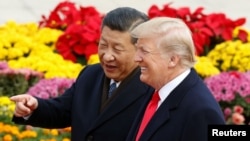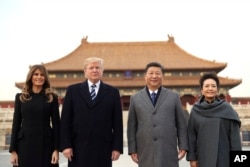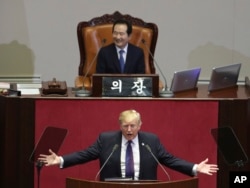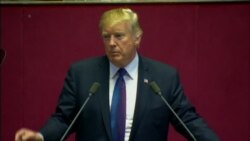U.S. President Donald Trump is holding talks with Chinese President Xi Jinping in which the U.S. leader has said he intends to press Beijing to get North Korea to abandon its nuclear weapons program.
At a welcoming ceremony early Thursday at the Great Hall of the People in Beijing, the two leaders walked side by side on a red carpet. The U.S. and Chinese national anthems were played by a military band and ceremonial cannon fire from Tiananmen Square saluted Trump. A crowd of jumping and gleeful schoolchildren waved American and Chinese flags.
The two leaders began talks behind closed doors. In the early afternoon, they are to appear jointly before journalists and make statements.
It is the first visit by Trump to China, which is North Korea’s closest and only remaining significant ally. The U.S. president is expected to request China expel North Korean workers from the country and eliminate some of its other significant remaining dealings with Pyongyang.
In remarks made during their extended bilateral talks, Trump said to Xi, regarding North Korea: "I believe there is a solution to that as you do."
The talks between Trump and Xi will also deal with trade, a touchy subject because Trump has long complained about the trade deficit between China and the United States.
China’s trade surplus with the United States has widened by 12.2 percent in the past year, reaching a total of $26.6 billion, according to Chinese customs data.
"Past administrations allowed it to get so far out of kilter," Trump said.
Business deals
Yet, the Trump administration is showcasing several business deals signed during the China trip, including a deal for China’s biggest online retailer to buy $1.2 billion of American beef and pork.
U.S. Commerce Secretary Wilbur Ross has said such business deals “are a good example” of how the United States “can productively build up our bilateral trade.”
Trump is also to meet Thursday with Chinese Premier Li Keqiang, whose position is similar to that of a prime minister.
Trump and his wife, Melania, were received with great pageantry on their arrival to China. The Trumps were also treated to a private visit to the Forbidden City, China’s ancient imperial palace. They also viewed an outdoor opera featuring costumes, music and martial arts.
After touring the Forbidden City, Trump told reporters, “We’re having a great time.”
The U.S. president arrived in Beijing a day after delivering a speech in Seoul, South Korea, in which he called on other nations to unite and “isolate the brutal regime of North Korea,” Trump said in his speech. “You cannot support, you cannot supply, you cannot accept,” he added.
In that speech to South Korea’s National Assembly, Trump had a forceful message for Pyongyang. He called on leader Kim Jong Un to give up all his nuclear weapons for a chance to step on to “a better path.”
Trump warned the North, “Do not underestimate us and do not try us. We will defend our common security, our shared prosperity and our sacred liberty.”
Backing the president’s words was the presence of three U.S. aircraft carrier strike groups and nuclear submarines, which the president said “are appropriately positioned” near the Korean peninsula.
'Total failure'
The U.S president referred to North Korea as “a total failure,” and a “twisted regime” ruled by a cult and a tyrant who enslaves his people — a characterization certain to provoke a harsh rhetorical reply from Pyongyang.
“The world cannot tolerate the menace of a rogue regime that threatens it with nuclear devastation,” said Trump in his speech. “All responsible nations must join forces to isolate the brutal regime of North Korea — to deny it any form of support.”
The U.S. leader had effusive praise for South Korea, contrasting its economic success with the dark situation in the North.
“The more successful South Korea becomes, the more decisively you discredit the dark fantasy at the heart of the Kim regime,” said the U.S. president.
WATCH: Trump Message to North Korean Leader
The speech ended on a hopeful note, which is the Korean dream: the peaceful reunification of the peninsula. But with Kim’s weapons of mass destruction posing a greater threat, Trump warned, “the longer we wait, the greater the danger grows and the few the options become.”
President Trump generally took a more optimistic view of diplomacy during his visit to Seoul, which included meetings with South Korean President Moon Jae-in. He said progress has been made to diffuse heightened tensions in the region, a striking departure from the tone of his tweets in recent weeks suggesting talks with Pyongyang to resolve the nuclear crisis were “a waste of time.”
Speaking on Air Force One on the approach to Beijing Wednesday, a senior White House official said President Trump and the South Korean leader had reaffirmed their commitment for a coordinated global pressure campaign to bring North Korea back to “authentic denuclearization talks,” while also remaining committed to use a “full range of military capabilities” to defend South Korea and Japan.
“Authentic” talks, the U.S. official said, would be without preconditions and would entail North Korea agreeing to “reduce the threat, end provocations, and move toward sincere steps to ultimately denuclearize.” Preconditions like refusing to put nuclear weapons on the table, the official said, “is a nonstarter” for the United States. The U.S. also maintains that any agreement would need to include verification of denuclearization efforts — a key sticking point in multi-nation negotiations that have been attempted in the past.
In a statement issued separately, White House Press Secretary Sarah Huckabee Sanders said Trump would also make a determination on whether the United States will designate North Korea as a state sponsor of terrorism before the end of his visit to China.
It is likely the president will continue to send out tweets while in China, despite a Chinese block on Twitter. Thanks to communications gear aboard Air Force One, the official said “The president will tweet whatever he wants.”
VOA's Bill Ide and Marissa Melton contributed to this report.



















